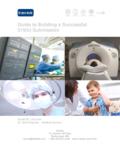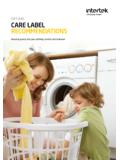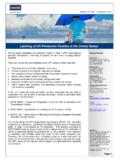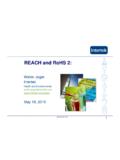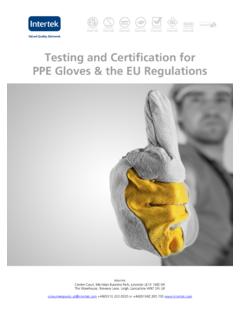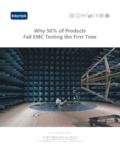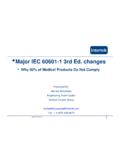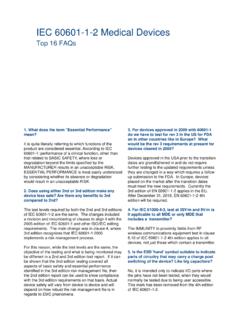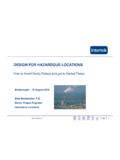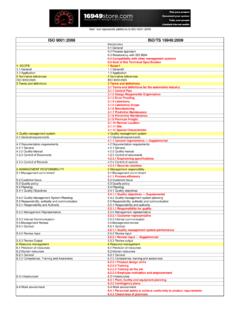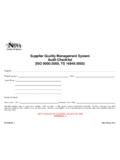Transcription of ISO/TS 16949:2009 - Auditing the Interactions of ...
1 ISO/TS 16949 : 2009 Auditing the Interactions of supporting Functions Vickie Betras ISO/TS 16949 : 2009 Auditing the Interactions of supporting Functions 1 Introduction ISO/TS 16949 : 2009 , section (Process Approach) states: ..For an organization to function effectively, it has to determine and manage numerous linked activities. This article will focus on the linked activities between remote supporting functions and the manufacturing plants they support. TS Rules section defines the requirements for supporting activities. supporting functions shall be audited as required to support a site; they will be included in the initial Stage 2 audit and at least once more during the surveillance audit cycle and the recertification audit. supporting activities can be on-site or remote, and can include functions such as product design, contract review, purchasing, and warehouses.
2 Your Responsibility As an ISO/TS 16949 : 2009 certified organization, you are responsible for defining the supporting functions and providing the necessary information to enable your certification body (CB) to establish a complete quotation. During the application process (TS Rules ) your organization s management representative will provide information to your CB including general information relevant for the scope of certification, the site address, all associated remote supporting location(s), and relationship in a larger corporation (if any). Your organization has the responsibility to determine the processes needed for the quality management system throughout the organization, and to determine the sequence and interaction of the processes (TS Rules ). Any remote supporting functions should be shown on the organization s process descriptions (maps) with the interaction identified.
3 The linkage between the plant and the support function should be defined. Additionally, this allows your organization to gain an understanding of how your ISO/TS 16949 : 2009 Auditing the Interactions of supporting Functions 2 processes work together with other processes (interact) to produce a product that meets customer requirements. Process owners should be identified. Processes can also be defined by a series of procedures, which together meet all the requirements of having all attributes of a process. It is up to you to determine what model works best for your organization. Some organizations may have all or some supporting activities housed under a head office or corporate support location; others may just have a warehouse or distribution center that supports multiple locations. To ensure your CB understands your processes and the interfaces, it is important that you supply pre-audit planning information to your CB for effective audit planning, including: Your identified processes, showing the sequence and Interactions , including remote support functions.
4 Current customer (scorecards) and internal performance data, internal audit and management review results, and information on any new customers. Review and Distribution of Support Employees The important requirements related to ISO/TS 16949 to consider are: The number of employees in supporting activities (remote or on-site) must be included in the total headcount and apportioned to each site. For remote/ supporting functions, only employees that support the manufacturing site should be counted for the minimum audit-day calculation. Key Point Processes must be defined to show the interface between the organization s sites and its support functions. ISO/TS 16949 : 2009 Auditing the Interactions of supporting Functions 3 supporting locations must be audited as they support the site; included in the initial Stage 2 audit (typically prior to the mfg site audit) and at least once more during the surveillance audit cycle and the recertification audit.
5 Design functions must be audited annually. Another point to consider is when the remote supporting location is audited by a different CB than the manufacturing site. The CB can accept the audit of the remote supporting location by another CB when certain conditions are met. It is your responsibility to provide the CB Auditing the manufacturing site with a copy of the audit plan, audit report, all findings, all corrective actions, and all verification actions from the CB for the remote supporting location. The audit team leader will ask the management representative to obtain the information in such cases. When the conditions cannot be met, the CB for the manufacturing site will notify you that an additional audit of the remote location is required based on TS Rules It is the responsibility of the CB to document how the required days are distributed between the sites. During the quotation process, time can be taken away from one or more of the manufacturing plants and used to audit the supporting functions (on-site time), but how this time is distributed needs to be documented by the CB.
6 Auditing Manufacturing Plants with Remote supporting Locations: An Example As an example, suppose an organization has three manufacturing sites and one support location that supports all three manufacturing sites for Sales and Product Design. The support site employees are apportioned to the sites, and the audit-day requirements for the sites are based on the apportioned number of employees. When Auditing the sites and the supporting location, there is audit planning and reporting information that must be appropriately documented to ensure the ISO/TS 16949 requirements are met. The following examples provide some guidance. Audit Planning and Execution Showing the Interaction on the Audit Plan During audit planning, for the site(s) above the auditor should consider the following: ISO/TS 16949 : 2009 Auditing the Interactions of supporting Functions 4 The audit of the interaction of the Sales and Design functions, and how they support the manufacturing site.
7 The audit plan should detail information related to the audit of the interaction of the site with the support function for the Sales and Design functions. The auditor should include in his audit samples the products manufactured at the site being audited that were sold and/or designed by the support location. The linkages you plan to audit at the manufacturing plant related to the supporting functions should be detailed on the audit plan. You do not need to make any special arrangements for support personnel to attend the audit at the manufacturing plant; but if the audit of the interface is detailed on the audit plan under the appropriate process, then you will be aware of the auditor s plan to review the linkage. The lead auditor will ensure adequate time is added to the audit of any process where support is being provided to the manufacturing site by remote supporting functions.
8 This will allow you to take an appropriate sample of the related records. The following examples provide some guidance. For Sales: Examples of Auditing the interface could be related to review of the following: Review of Documents Feasibility reviews, RFQ s, Quotes, s, etc. TS Customer Specific Requirements Specific quoting or APQP forms mandated by the customer, special instructions identified on the For Design: Examples of Auditing the interface could be related to review of the following: Design Planning The management of interfaces between different groups involved in design and development to ensure effective communication and clear assignment of responsibility. Multidisciplinary Approach Involvement of the manufacturing plant personnel, as appropriate, in design planning and design reviews. This ISO/TS 16949 : 2009 Auditing the Interactions of supporting Functions 5 includes preparing for product realization, development and review of plant layouts and process flows, control plans, DFMEA and PFMEA, control of special characteristics, error proofing, etc.
9 Design Reviews Normally coordinated with the design phase, these include manufacturing process design and development. Verification of Plant Level Documents (Drawings and Specifications) Appropriate plant personnel are made aware of changes to documents and of the changed requirements. Audit Reporting Documenting What Interfaces Were Audited When the audit is complete and the audit report is prepared, it needs to include information on what was audited related to the interface of the Sales and Design supporting functions. During audit reporting, the auditor should consider the following: The audit report must detail the linkages audited by the audit team. It is not enough just to indicate that the audit included an audit of the linkage to the Sales and Design support provided by the support location. The audit report should include information on specific products and projects reviewed: specific documents verified, part numbers, project numbers, etc.
10 Any customer-specific requirements verified related to supporting functions should be detailed in the audit report. For example: o The auditor may verify the Ford Specific requirement related to Ford Engineering & STA approval of PFMEA and control plans with inverted delta component(s). o Design FMEA(s) for inverted delta component(s) prepared by design-responsible suppliers require Ford Engineering approval. Keep in mind that any nonconformance issued as a result of the audit of the linkages at the plant level should be under the audit of the plant level process, not the responsibility of the supporting location. ISO/TS 16949 : 2009 Auditing the Interactions of supporting Functions 6 Auditing Remote supporting Locations that Support Manufacturing Plants In our example, the organization has a remote supporting location that supports three manufacturing sites for Sales and Product Design.
